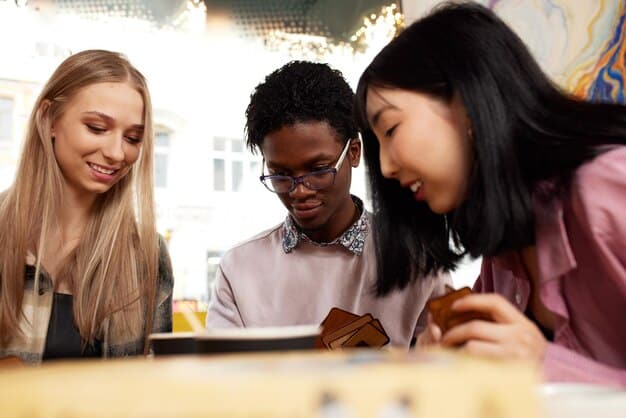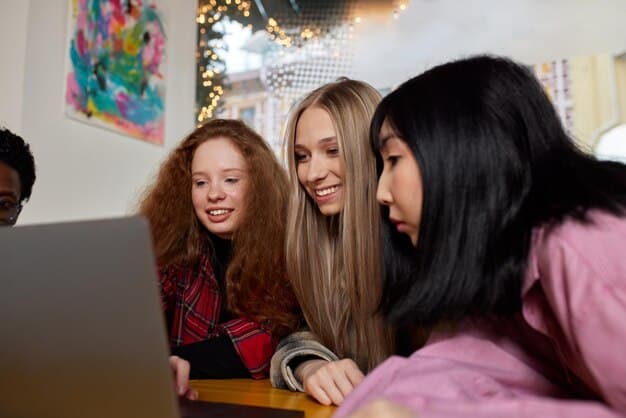Gen Z Collaborative Learning: Skills & Achievement Impact

Collaborative learning strategies significantly enhance Gen Z’s social skills and academic achievement by fostering teamwork, communication, and critical thinking within educational settings, preparing them for future challenges.
In an increasingly interconnected world, understanding how does the use of collaborative learning strategies impact social skills and academic achievement in Gen Z becomes paramount. This demographic, having grown up surrounded by digital connectivity, navigates unique social and learning landscapes. As educators and policymakers seek effective pedagogical approaches, examining the role of collaborative learning in shaping not just academic outcomes but also crucial social competencies offers vital insights.
The Foundational Shift: Why Collaborative Learning Matters for Gen Z
Generation Z, broadly defined as those born between the mid-1990s and early 2010s, exhibits distinct characteristics shaped by their digital native status. They are often individualistic, highly connected, and accustomed to instant information. Traditional, didactic teaching methods may not fully engage this cohort, making collaborative learning strategies particularly relevant.
Collaborative learning, at its core, involves students working together in small groups to achieve a common goal. This pedagogical approach contrasts sharply with competitive or purely individualistic learning models. For Gen Z, who thrive on connectivity and peer interaction, this method can transform passive absorption into active engagement, fostering environments where diverse perspectives are valued and collective problem-solving is the norm.
Digital Natives and Social Dynamics
Growing up with social media and instant messaging, Gen Z is hyper-aware of social dynamics, yet paradoxically, some report feeling more isolated despite constant digital connection. Collaborative learning provides structured, face-to-face interaction, which can bridge this gap by compelling them to communicate, negotiate, and understand different viewpoints in real-time. This dynamic setting moves beyond superficial digital interactions to cultivate deeper interpersonal skills.
- Enhanced Communication: Students must articulate ideas clearly and listen actively.
- Conflict Resolution: Group work inherently presents disagreements, requiring students to learn negotiation.
- Empathy Development: Working closely with peers fosters understanding of diverse backgrounds and perspectives.
- Leadership and Followership: Roles naturally emerge, allowing students to practice both guiding and supporting.
Moreover, the skills developed in these real-world collaborative settings are highly transferable to future workplaces, where teamwork and interdisciplinary projects are increasingly common. Education, therefore, becomes not just about content mastery but also about holistic skill development for global citizenship.
The intentional integration of collaborative tasks ensures that Gen Z students develop social competencies that extend beyond their digital comfort zones, preparing them for a complex, interconnected world. These strategies move students from individual silos to integrated learning communities, mirroring professional environments.
Impact on Academic Achievement: Beyond Rote Learning
While the social benefits of collaborative learning are evident, its influence on academic achievement is equally compelling. For Gen Z, who value relevance and applicability, collaborative tasks often provide a context that makes abstract concepts more tangible and engaging. This engagement translates directly into improved academic outcomes.
When students teach each other, review material together, or solve complex problems in groups, they deepen their understanding. This process, often referred to as “peer instruction,” can be profoundly effective because students often grasp concepts better when explained by a peer using simpler language or different examples than an instructor might. This active processing of information solidifies learning and retention.
Deepening Understanding and Critical Thinking
Collaborative projects typically require students to analyze information, synthesize ideas, and apply knowledge to new situations – all hallmarks of higher-order thinking skills. Instead of merely memorizing facts, Gen Z students must critically evaluate information shared by their peers, defend their own positions, and collectively construct solutions. This elevates learning from surface-level recall to deep conceptual understanding.
- Enhanced Problem-Solving: Diverse perspectives often lead to more innovative solutions.
- Increased Retention: Active engagement and peer teaching reinforce memory.
- Motivation and Engagement: The social aspect often makes learning more enjoyable and less intimidating.
- Accountability: Students are often more accountable to their peers than to an instructor, driving participation.
Academic achievement expands beyond grades; it encompasses the development of intellectual curiosity and a lifelong love of learning. Collaborative strategies foster these by making learning an interactive, dynamic process where students are co-creators of knowledge rather than passive recipients. This shift is crucial for Gen Z, who seek meaning and relevance in their educational pursuits.
The academic gains from collaborative learning are not only quantitative, reflected in test scores, but also qualitative, seen in students’ ability to transfer knowledge across domains and to engage in sustained inquiry. This holistic approach to achievement is what truly empowers Gen Z for future success.
Challenges and Considerations for Implementation
While the benefits of collaborative learning are substantial, implementing these strategies effectively with Gen Z requires careful consideration of potential challenges. Simply assigning group work does not guarantee positive outcomes; thoughtful planning and facilitation are essential. Educators must address issues such as differing skill levels, potential for free-riding, and the need for clear guidelines.
A common challenge is ensuring equitable participation. Some students may dominate group discussions, while others may withdraw. Effective collaborative learning requires strategies to promote equal voice, such as assigning specific roles within groups, rotating leadership, or using tools that ensure every member contributes meaningfully to the final output. This calls for intentional structuring of activities rather than mere informal grouping.
Structuring for Success: Mitigating Pitfalls
One of the primary concerns is the “free-rider” phenomenon, where certain group members contribute little while still benefiting from the group’s success. To counteract this, clear individual accountability measures are crucial. This can involve individual assessments alongside group grades, peer evaluations, or requiring each student to present specific components of the group project. Establishing transparent expectations upfront helps mitigate these issues.
Another consideration is dealing with conflicts. Although learning conflict resolution is a benefit, unresolved conflicts can derail group progress. Educators need to provide explicit instruction on effective communication, active listening, and constructive feedback. Role-playing scenarios or guided discussions on managing disagreements can equip Gen Z students with the tools they need to navigate interpersonal challenges within a group setting.
- Clear Expectations: Define roles, responsibilities, and success criteria for each group member.
- Individual Accountability: Implement strategies like individual quizzes or peer evaluations.
- Skill Building: Teach active listening, constructive feedback, and conflict resolution explicitly.
- Diverse Grouping: Strategically form groups to balance skills, personalities, and backgrounds.
Furthermore, technology, while a strength for Gen Z, can also be a distraction. Providing clear guidelines on technology use during collaborative sessions – whether it’s leveraging online tools for shared documents or restricting social media during designated work times – is important. The goal is to harness technology’s power for collaboration without letting it detract from focused interaction.
Ultimately, successful implementation lies in intentional design. It’s about providing the right support, clear structure, and continuous feedback to ensure that collaborative learning is a positive and productive experience for every Gen Z student, transforming potential challenges into learning opportunities.

Specific Collaborative Strategies and Their Efficacy
The umbrella term “collaborative learning” encompasses a wide array of specific strategies, each with its own nuances and applications. Understanding these variations can help educators select the most effective approach for particular learning objectives and for engaging Gen Z students effectively. Not all strategies are equally suited for all contexts or desired outcomes.
One popular strategy is the “jigsaw” method, where each student in a group becomes an expert on a specific part of a larger topic and then teaches their segment to the rest of the group. This method intrinsically promotes individual accountability and interdependence, as the success of the group hinges on each member’s expertise and teaching ability. It encourages deep dives into specific content while fostering comprehensive understanding.
Exploring Varied Methodologies
Another effective approach is “problem-based learning” (PBL), where students work in groups to solve complex, real-world problems. This method is highly engaging for Gen Z due to its relevance and practical application. PBL encourages critical thinking, research skills, and collaborative problem-solving, making abstract concepts concrete and motivating students to seek out knowledge to address the challenge at hand.
“Think-Pair-Share” is a simpler, yet powerful, strategy that can be seamlessly integrated into daily lessons. Students first think individually about a question, then discuss their thoughts with a partner, and finally, share their conclusions with the larger class. This scaffolded approach allows quieter students to formulate their ideas before speaking publicly, enhancing participation and confidence.
- Project-Based Learning: Long-term projects that integrate multiple subjects and require collaboration.
- Reciprocal Teaching: Students take turns leading discussions, summarizing, questioning, clarifying, and predicting.
- Peer Tutoring: More knowledgeable students assist those who are struggling, benefiting both.
- Online Collaboration Tools: Utilizing digital platforms for shared documents, virtual whiteboards, and group discussions.
The efficacy of these strategies often lies in their ability to cater to diverse learning styles within Gen Z. Some students may prefer auditory processing through discussions, others visual aids created collaboratively, and still others kinesthetic learning through active project building. Variety in collaborative approaches ensures that a wider range of students can engage effectively and find their role within the learning process.
By thoughtfully selecting and implementing specific collaborative strategies, educators can create dynamic learning environments that resonate with Gen Z’s characteristics. This tailored approach maximizes the positive impact on both social skill development and academic achievement, leading to more engaged and capable learners.
Measuring Impact: Social Skills and Academic Growth
To truly understand how collaborative learning strategies impact social skills and academic achievement in Gen Z, it is essential to employ robust methods for measuring these impacts. Measurement goes beyond traditional test scores, encompassing observational data, self-assessments, and evaluations of interpersonal competencies. A multi-faceted approach provides a comprehensive picture of student growth.
For social skills, standardized rubrics can assess communication, teamwork, conflict resolution, and leadership within group projects. Peer evaluations provide valuable insights into individual contributions and group dynamics, offering a perspective that complements instructor observations. Self-reflection journals can prompt students to consider their own growth in areas like active listening and empathy.
Quantitative and Qualitative Assessments
Academically, beyond traditional exams, project-based assessments can more accurately reflect the depth of understanding gained collaboratively. These might include group presentations, research papers, or prototype development. Performance on these complex tasks often demonstrates higher-order thinking skills fostered through collaboration, which simpler tests might miss. Comparing individual performance before and after collaborative interventions can reveal academic growth.
Surveys and interviews with Gen Z students themselves offer qualitative data, capturing their perceptions of how collaborative learning affects their engagement, motivation, and sense of belonging. Understanding their experiences directly can provide context for quantitative results and highlight areas for pedagogical refinement. For instance, students might report feeling more confident in presenting ideas after engaging in multiple group discussions.
- Observational Rubrics: Assess group process, communication, and task completion.
- Peer and Self-Assessments: Evaluate individual contributions and social skill development.
- Project-Based Grading: Measure academic outcomes through collaborative deliverables.
- Attitudinal Surveys: Gauge student engagement, motivation, and perceived learning gains.
Longitudinal studies tracking Gen Z cohorts could further illuminate the lasting impact of collaborative learning on their social well-being and career trajectories. Do students who consistently engage in collaborative learning demonstrate superior teamwork skills in their early careers? Do they report higher job satisfaction or career advancement attributable to their interpersonal competencies?
Comprehensive measurement allows educators to refine their collaborative strategies, ensuring they are not just implemented, but that they are effective. Continuously assessing impact enables data-driven decisions that best support Gen Z’s holistic development, cementing the value of collaborative learning in modern educational frameworks.
Future Implications: Preparing Gen Z for a Dynamic World
Looking ahead, the intentional cultivation of social skills and academic achievement through collaborative learning strategies has profound implications for preparing Gen Z for a world characterized by rapid change, complex challenges, and increasing interdependence. The skills developed through collaboration are not just academic advantages; they are life-long necessities.
The global workforce increasingly demands adaptability, innovative thinking, and the ability to work effectively across diverse teams. Gen Z, as future leaders and innovators, will navigate complex societal and technological landscapes. Collaborative learning inherently builds resilience, critical problem-solving capabilities, and the interpersonal finesse required to succeed in such environments.
Lifelong Skills for a Changing Landscape
Furthermore, an emphasis on collaborative learning in educational institutions can foster a culture of shared responsibility and collective achievement, counteracting tendencies towards isolation or extreme individualism. By learning to rely on and support one another academically, Gen Z can develop a stronger sense of community and a deeper appreciation for collective intelligence.
As artificial intelligence and automation reshape industries, human-centric skills like creativity, emotional intelligence, and complex social interaction will become even more valuable. Collaborative learning provides a unique training ground for these indispensable attributes, positioning Gen Z not just as consumers of technology, but as ethical and effective collaborators with it.
- Workforce Readiness: Fosters skills directly applicable to modern collaborative workplaces.
- Global Citizenship: Encourages understanding and working with diverse perspectives.
- Adaptability: Prepares individuals to solve novel problems in dynamic environments.
- Innovation: Promotes creative synergy and interdisciplinary thinking.
The journey of learning should empower individuals to thrive, not just survive. For Gen Z, who are digital natives facing unprecedented global challenges, collaborative learning stands as a robust pedagogical approach that nurtures both the intellectual rigor and social dexterity essential for thriving in the 21st century. It’s an investment in their holistic development, ensuring they are well-equipped to contribute meaningfully to society.
The continued evolution of education must recognize the unique traits of Gen Z and leverage strategies that resonate with their inherent connectivity and desire for relevant learning experiences. Collaborative learning is not merely an educational trend; it is a fundamental shift towards preparing a generation that is not only smart but also socially adept and globally conscious.

| Key Aspect | Brief Description |
|---|---|
| 🤝 Social Skills | Enhances communication, conflict resolution, and empathy through group interaction. |
| 📈 Academic Growth | Deepens understanding, promotes critical thinking, and boosts engagement beyond rote learning. |
| 🛠️ Implementation | Requires clear structures, individual accountability, and explicit skill-building for success. |
| 🌍 Future Readiness | Prepares Gen Z for dynamic workplaces and global challenges by fostering adaptable, human-centric skills. |
Frequently Asked Questions About Collaborative Learning for Gen Z
Collaborative learning for Gen Z involves structured educational strategies where students work together in small groups to achieve common academic goals. This approach leverages their natural inclination towards connectivity and peer interaction, fostering deeper understanding and significant social skill development beyond traditional individualistic learning models.
It significantly enhances social skills by requiring direct interpersonal communication, negotiation, and conflict resolution within groups. Students learn active listening, empathy, and how to articulate their ideas effectively face-to-face, moving beyond their digital comfort zones to develop essential real-world social competencies for future success in diverse settings.
Yes, collaborative learning positively impacts academic achievement for Gen Z by promoting deeper understanding and critical thinking. Through peer teaching, problem-based learning, and shared inquiry, students actively process information, apply knowledge, and consolidate learning, leading to improved retention and higher-order thinking skills that go beyond rote memorization for exams.
Challenges include ensuring equitable participation and managing “free-riders.” Effective implementation requires clear guidelines, individual accountability measures like peer evaluations, and explicit instruction on communication and conflict resolution. Careful group formation and appropriate use of technology are also vital to maximize benefits and mitigate potential pitfalls for students.
It prepares Gen Z for a dynamic, interconnected world by cultivating essential human-centric skills. These include adaptability, complex problem-solving, innovative thinking, and effective teamwork—skills increasingly valued over rote knowledge. By fostering resilience and social dexterity, collaborative learning ensures Gen Z is well-equipped for future careers and global citizenship in a rapidly evolving landscape.
Conclusion
The journey to understand how collaborative learning strategies impact social skills and academic achievement in Gen Z reveals a powerful synergy. These pedagogical approaches aren’t merely supplemental; they are foundational for nurturing a generation that is not only academically proficient but also socially astute and prepared for a complex world. By fostering environments where cooperation, critical thinking, and clear communication are paramount, educators can equip Gen Z with the tools they need to succeed in an increasingly interconnected future. This holistic approach ensures that learning extends far beyond the classroom, building the resilient, adaptable, and collaborative individuals society needs.





